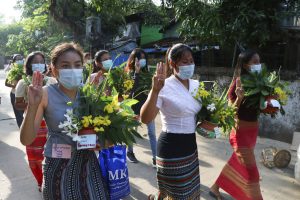Anti-coup protesters in Myanmar have exchanged feasting for protests and water for red paint, as they maintained low-key resistance against the military junta through the Buddhist New Year.
Tuesday marked the beginning of the five-day Thingyan holiday, which marks the beginning of the year in Theravada Buddhist countries. In typical years, the nation grinds to a halt for Thingyan, which is typically celebrated with feasts, the ritual cleaning of Buddha images, and raucous public water fights.
This is the second year on end that Myanmar has not seen Thingyan celebrations, after the festivities were canceled last year (as in neighboring Thailand and Cambodia) due to COVID-19. But many protesters say that refusing to take part in traditional festivities is an important way of undermining the regime’s claim that the situation in Myanmar has returned to normal.
“This year, we will mark Thingyan only with revolutionary chants,” poet and Mandalay resident Kyaw Gyi told the local outlet Myanmar Now.
Activists have planned different shows of defiance every day over the holiday, which comes to an end on Saturday. On Tuesday, women protested in several cities holding traditional pots containing flowers and that are traditionally associated with Thingyan, while their procession was blessed by onlookers with water splashed from the branches of Eugenia bushes.
The following day, activists organized a “bloody paint strike,” in which protesters doused red paint on pavements, buildings, and the signs of government buildings. One participant in the protest told Agence France-Presse that the purpose of the activity was to “remember the martyrs who died in the struggle for democracy.”
Since the military’s seizure of power on February 1, at least 715 people have been killed by security forces – both protesters and bystanders – while more than 3,000 languish in custody, according to the Assistance Association for Political Prisoners.
Things have remained relatively calm in Yangon and other major cities since the beginning of Thingyan, but this calm is unlikely to hold beyond the holiday’s end. The weekend before Thingyan saw at least 82 people (and possibly more) killed by the army in the city of Bago, Myanmar’s fourth-largest city, during which troops allegedly deployed heavy weapons to break up protests.
The junta has also kept up its offensives on other fronts. On Tuesday, it charged Aung San Suu Kyi, the deposed head of the National League for Democracy (NLD) government, with breaching a law intended to control the spread of COVID-19, the second such charge she faces under that law. (Meanwhile, the coup has led to a collapse in the state’s COVID-19 testing and vaccination efforts.) Aung San Suu Kyi already faces charges of illegally importing walkie-talkies, inciting public unrest, and breaking the country’s colonial-era Official Secrets Act, as well as being accused of taking bribes.
The following day, the junta announced that it had charged at least 19 medical doctors for participating in civil disobedience protests, in particular, for “deteriorating the state administrative machinery.” This came after the state media announced that a court martial had handed down death sentences to 19 people (17 of them in absentia) for killing an associate of an army captain in the North Okkalapa district of Yangon. Martial law was declared in North Okkalapa and other parts of the city’s industrial outskirts after massive protests there last month.
The death sentences reflect the increasing numbers of protesters who, after two and a half months of protests, are beginning to mount their own improvised form of armed resistance to military rule. Such resistance has been particularly strong in Sagaing Region, where a number of soldiers have been killed in violent confrontations with protesters.
While the army has been taking casualties for decades along the country’s periphery in its often self-defeating attempts to quell ethnic insurgencies, for such casualties to take place in the central, ethnic Bamar-dominated regions of the country suggests a broadening of Myanmar’s conflicts to engulf the whole country.
With the economy in freefall, ethnic armed groups launching fresh offensives in the borderlands, and anti-coup protesters turning to increasingly forceful methods to resist the junta, it looks likely that Thingyan marks simply a temporary pause in hostilities. Indeed, the most likely outcome now is a grinding stalemate in which victory for either side is mostly impossible.
As the U.S.-ASEAN Business Council put it in a briefing on Tuesday, “there is not much else in Myanmar’s political forecast than a bleak and bloody picture awaiting to unfold in the coming weeks. Things will, of course, always get better after they get worse but unfortunately, it is fair to say that we have not seen the worst of the situation in Myanmar.”

































